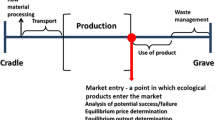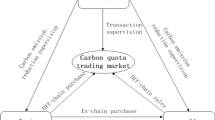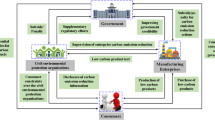Abstract
In response to escalating consumer demand for environmentally sustainable goods, China faces significant challenges in advancing green technology and ensuring sustainable production–consumption cycles through effective environmental governance. The eco-cost system supported by the European Union acts as a tool to convert consumer ecological preferences into manufacturing practices and provides regulators with quantifiable ecological metrics essential for meeting sustainability benchmarks. However, the practical application of the eco-cost framework to stimulate sustainable production–consumption dynamics in China is still an empirical question. This research examines the feasibility of the eco-cost system within China's sustainability strategy, using evolutionary game theory to model the interactions among consumers, producers, and regulators. The simulation predicts that consumer preference for eco-labeled products with lower eco-cost indices and their favored status among similar options will encourage manufacturers to initiate greening efforts, reducing environmental degradation in the production stage. This strategic consumer behavior is expected to lead to significant reductions in China's labor and fiscal expenditures, optimizing the dividends of resources, energy, and the environment. Empirical evidence supports the eco-cost system as an effective framework for China to achieve its sustainable production–consumption goals.




















Similar content being viewed by others
Data availability statement
All data generated or analyzed during this research are included in this published article.
References
Ateş, H. (2021). Understanding students’ and science educators’ eco-labeled food purchase behaviors: Extension of theory of planned behavior with self-identity, personal norm, willingness to pay, and eco-label knowledge. Ecology of Food and Nutrition, 60(4), 454–472.
Benettin, G., Galgani, L., Giorgilli, A., & Strelcyn, J. M. (1980). Lyapunov characteristic exponents for smooth dynamical systems and for hamiltonian systems; a method for computing all of them. Part 1: Theory. Meccanica, 15, 9–20.
Chan, K. M., & Satterfield, T. (2020). The maturation of ecosystem services: Social and policy research expands, but whither biophysically informed valuation? People and Nature, 2(4), 1021–1060.
CIRC4LIFE. 2018. CIRC4Life: A circular economy approach for lifecycles of products and services [M] //E. C. H. PROGRAMME.
COMMISSION E. 2012. FP7 projects [M].
COMMISSION’S E. 2018. EU H2020 project: CIRC4life—A circular economy approach for lifecycles of products and services.
Council S. (2018). the first meeting of the financial and economic commission of the CPC central committee. (In Chinese) [M]. Central People's Government of the People's Republic of China.
Di, J., Xu, M., Zhang, W., Tong, X., He, X., Gao, H., & Wang, B. (2018). Combinations of soil properties, carbon inputs and climate control the saturation deficit dynamics of stable soil carbon over 17-year fertilizaiton. Scientific Reports, 8(1), 12653.
Eberhardt, L. C. M., Stijn, A. V., Rasmussen, F. N., et al. (2020). Development of a life cycle assessment allocation approach for circular economy in the built environment. Sustainability, 12, 9579.
FinkbeinerVanessa, M. B. (2021). Life cycle assessment of decarbonization options—towards scientifically robust carbon neutrality. International Journal of Life Cycle Assessment, 26, 635–639.
Hang, N. P. T. (2022). Policy implications for the green bank development in the context of global climate change. Emerging Science Journal, 6(4), 817–833.
Huang, A. (2017). A framework and metrics for sustainable manufacturing performance evaluation at the production line, plant and enterprise levels.
Huijbregts, M. A., Steinmann, Z. J., Elshout, P. M., Stam, G., Verones, F., Vieira, M. D., & van Zelm, R. (2016). ReCiPe 2016: a harmonized life cycle impact assessment method at midpoint and endpoint level report I: characterization.
Jiang, K., You, D., Merrill, R., et al. (2019). Implementation of a multi-agent environmental regulation strategy under Chinese fiscal decentralization: An evolutionary game theoretical approach. Journal of Cleaner Production, 214, 902–915.
Johannes, B., Liedtke, C., & Bienge, K. (2017). How much environment do humans need? Evidence from an integrated online user application linking natural resource use and subjective well-being in Germany. Resources, 6, 67.
Kaur, A., & Chahal, H. (2018). Role of social media in increasing environmental issue awareness. Researchers World, 9, 19.
Kautish, P., Paul, J., & Sharma, R. (2019). The moderating influence of environmental consciousness and recycling intentions on green purchase behavior. Journal of Cleaner Production, 228, 1425–1436.
Khan, K. I., Mata, M. N., Martins, J. M., et al. (2022). Impediments of green finance adoption system: Linking economy and environment. Emerging Science Journal, 6, 217–237.
Khan, M. H., & Muktar, S. N. (2021). What’s next for green human resource management: Insights and trends for sustainable development. International Journal of Sustainable Development and Planning, 16(1), 181–194.
Li, M., & Gao, X. (2022). Implementation of enterprises’ green technology innovation under market-based environmental regulation: An evolutionary game approach. Journal of Environmental Management, 308, 114570.
Li, X., Zhang, J., Gong, Y., et al. (2020). Status of mercury accumulation in agricultural soils across China (1976–2016). Ecotoxicology and Environmental Safety, 197, 110564.
Li, Y., Nai-Ming, X., & Aqin, H. (2021). A novel time-delay multivariate grey model for impact analysis of CO2 emissions from China’s transportation sectors. Applied Mathematical Modelling, 91, 493–507.
Manfredi, S. E. A. (2012). Product environmental footprint (PEF) guide institute for environment and sustainability (IES) Product environmental footprint guide [M].
Zita, M., Burger, C., & Scholtz, B. (2014, September). The Use of Social Media as an Enabler to Create Environmental Awareness of Staff in Higher Education. In EnviroInfo (pp. 405-412).
Mcelnea, W. K. (2011). Sustainable manufacturing initiative: U.S. department of commerce. International Journal of Powder Metallurgy, 47, 12–16.
Michael, L. (2018). Lifestyle material footprint of Finnish households—Insights, targets, transitions.
Mironova, N., Yefremova, O., Biletska, H., et al. (2022). Soil quality evaluation in urban ecosystems during the covid-19 pandemic. HighTech and Innovation Journal, 3, 43–51.
Monteiro, H., Cruz, P. L., & Moura, B. (2022). Integrated environmental and economic life cycle assessment of improvement strategies for a ceramic industry. Journal of Cleaner Production, 345, 131173.
Nydrioti, I., & Grigoropoulou, H. (2023). Using the water footprint concept for water use efficiency labelling of consumer products: The Greek experience. Environmental Science and Pollution Research, 30(8), 19918–19930.
Ouyang, Z., Zhu, C., Yang, G., Xu, W. H., Zheng, H., Zhang, Y., & Xiao, Y. (2013). Gross ecosystem product: Concept, accounting framework and case study. Acta Ecologica Sinica, 33(21), 6747–6761.
Page, G., Simmons, A., Ridoutt, B., Badgery, W., & Bellotti, B. (2014). Using life cycle approach to evaluate trade-offs associated with payment for ecosystem services schemes.
Pedersen, E., & Remmen, A. (2022). Challenges with product environmental footprint: A systematic review. The International Journal of Life Cycle Assessment, 27(2), 342–352.
Peng, W., Su, D., & Wang, S. (2021). Development of an innovative ICT infrastructure for an eco-cost system with life cycle assessment. Sustainability, 13(6), 3118.
Qing, X., Jiquan, Z., Yanan, C., et al. (2020). Pollution, sources and human health risk assessment of potentially toxic elements in different land use types under the background of industrial cities. Sustainability, 12, 2121.
Santos, V., Gomes, S., & Nogueira, M. (2021). Sustainable packaging: Does eating organic really make a difference on product-packaging interaction? Journal of Cleaner Production, 304, 127066.
Schaubroeck, T., Gibon, T., Igos, E., & Benetto, E. (2021). Sustainability assessment of circular economy over time: Modelling of finite and variable loops & impact distribution among related products. Resources, Conservation and Recycling, 168, 105319.
Shahzad, M., Qu, Y., Zafar, A. U., Rehman, S. U., & Islam, T. (2020). Exploring the influence of knowledge management process on corporate sustainable performance through green innovation. Journal of Knowledge Management, 24(9), 2079–2106.
Shimul, A. S., Cheah, I., & Khan, B. B. (2022). Investigating female shoppers’ attitude and purchase intention toward green cosmetics in South Africa. Journal of Global Marketing, 35(1), 37–56.
Shuaib, M., Seevers, D., Zhang, X., Badurdeen, F., Rouch, K. E., & Jawahir, I. S. (2014). Product sustainability index (ProdSI) a metrics-based framework to evaluate the total life cycle sustainability of manufactured products. Journal of Industrial Ecology, 18(4), 491–507.
Śmiglak-Krajewska, M., & Wojciechowska-Solis, J. (2021). Consumer versus organic products in the COVID-19 pandemic: Opportunities and barriers to market development. Energies, 14(17), 5566.
Su, D. (2020). Introduction and sustainable product development.
Tanguay, X., Essoua Essoua, G. G., & Amor, B. (2021). Attributional and consequential life cycle assessments in a circular economy with integration of a quality indicator: A case study of cascading wood products. Journal of Industrial Ecology, 25(6), 1462–1473.
Tlebere, T., Scholtz, B., & Calitz, A. P. (2016). Using social media to improve environmental awareness in higher education institutions
Ting, H. C., Khan, H. W., Reddy, A. V. B., Goto, M., & Moniruzzaman, M. (2022). Extraction of salicylic acid from wastewater using ionic liquid-based green emulsion liquid membrane: COSMO-RS prediction and experimental verification. Journal of Molecular Liquids, 347, 118280.
Tong, S., Li, H., Wang, L., Tudi, M., & Yang, L. (2020). Concentration, spatial distribution, contamination degree and human health risk assessment of heavy metals in urban soils across China between 2003 and 2019—A systematic review. International Journal of Environmental Research and Public Health, 17(9), 3099.
UNEP. (2021). The Production Gap report 2021 [M].
Uusitalo, E., Kuokkanen, A., Uusitalo, V., et al. (2021). Personal carbon trading in mobility may have positive distributional effects. Case Studies on Transport Policy, 9, 315–323.
Wang, H., Chen, L., & Liu, J. (2022). An evolutionary game theory analysis linking manufacturing, logistics, and the government in low-carbon development. Journal of the Operational Research Society, 73(5), 1014–1032.
Wang, J. (2016). Revive China’s green GDP programme. Nature, 534, 37–37.
Yin, S., Zhang, N., & Li, B. (2020). Enhancing the competitiveness of multi-agent cooperation for green manufacturing in China: An empirical study of the measure of green technology innovation capabilities and their influencing factors. Sustainable Production and Consumption, 23, 63–76.
Zhang, G., Zhang, Z., Cui, Y., et al. (2016). Game model of enterprises and government based on the tax preference policy for energy conservation and emission reduction. Filomat, 30, 3963–3974.
Zhao, R., Wu, D., & Zhang, J. (2021). Policy implications on carbon labeling scheme toward carbon neutrality in China. Frontiers in Environmental Science, 9, 739943.
Ziying, Z., Tong, W., Yi, X., et al. (2020). Valuing natural capital amidst rapid urbanization: Assessing the gross ecosystem product (GEP) of China’s ‘Chang-Zhu-Tan’ megacity. Environmental Research Letters, 15, 124019.
Author information
Authors and Affiliations
Corresponding author
Ethics declarations
Conflict of interest
The authors declare that they have no known competing financial interests or personal relationships that could have appeared to influence the work reported in this paper.
Additional information
Publisher's Note
Springer Nature remains neutral with regard to jurisdictional claims in published maps and institutional affiliations.
Appendices
Appendix
Analysis of the strategic stability of manufacturers:
The first derivative of \(x\) and the set \(G\left( y \right)\) are, respectively:
Analysis of the strategic stability of consumers:
Analysis of the strategic stability of China government regulators:
Rights and permissions
Springer Nature or its licensor (e.g. a society or other partner) holds exclusive rights to this article under a publishing agreement with the author(s) or other rightsholder(s); author self-archiving of the accepted manuscript version of this article is solely governed by the terms of such publishing agreement and applicable law.
About this article
Cite this article
Yu, L., Zhu, S. Advanced game model of multi-agent environmental regulation strategy for sustainable production and consumption. Environ Dev Sustain (2024). https://doi.org/10.1007/s10668-023-04283-w
Received:
Accepted:
Published:
DOI: https://doi.org/10.1007/s10668-023-04283-w




